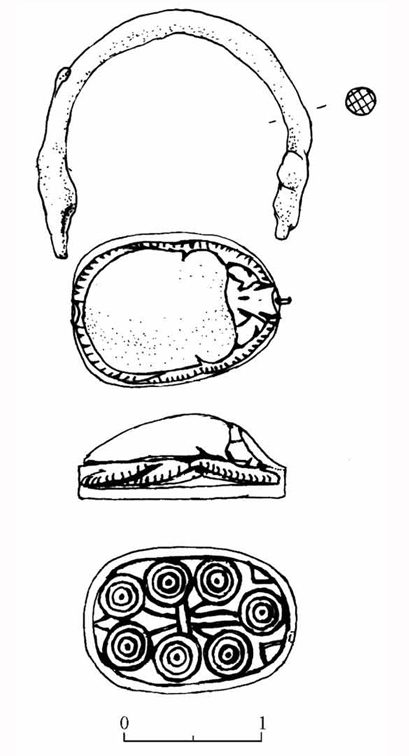Tel Jatt is located beneath the modern village of Jatt, east of the city of Hadera. The tell is situated on chalk hills at the junction between the Samarian hills to the east and the Sharon plain to the west. It is bounded by a steep slope, standing approximately 120 meters above sea level, and lies close to the Via Maris (Way of the Sea). The site is commonly identified with “Gath-Padalla,” one of the cities mentioned in the conquest records of Pharaoh Thutmose III. Tel Jatt was surveyed in the 1960s and 1970s, and over the years, primarily rescue excavations and inspections have been conducted by the Israel Antiquities Authority. These efforts indicate that the settlement at Tel Jatt existed from the Early Bronze Age I (late 4th millennium BCE) through to the Middle Ages. Notable findings include Egyptian scarabs and a variety of imported pottery. In a Roman-era burial cave, inscriptions in Hebrew-Aramaic were found, bearing the names “Yeshua,” “Yaakov,” and “Rivka.”


View of the modern village of Jatt from the west (the tel is located on the highest point of the village). By ת.ר. Pikiwiki Israel, CC BY 2.5, https://commons.wikimedia.org/w/index.php?curid=25295814
Identification and excavation history
The name “Jatt” preserves the ancient name “Gath,” common in biblical times, often with an additional identifying name (e.g., “Gath of the Philistines“). Jatt is typically identified with “Gath-Padalla,” mentioned in the city lists conquered by Pharaoh Thutmose III (1474-1421 BCE). Petrographic analysis of the El-Amarna Letters (14th century BCE) has allowed the identification of Jatt with Ginti-Carmel, ruled by Tagi. Professor Nadav Na’aman suggested identifying Jatt with the city “Zadpath,” referenced in Pharaoh Shishak’s campaign in 925 BCE.
The site was first surveyed by Ram Gophna and Yosef Porat in 1968, followed by another survey in 1974 by Yehuda Na’aman. In 1984, Eli Yannai conducted a rescue excavation for the Israel Antiquities Authority (IAA), focusing on Roman-era burial caves. Another rescue excavation of a burial cave was conducted in 2000 by Karem Said of the IAA. In 2005, a rescue excavation near the modern village’s community center was led by Gilad Cinamon of the IAA, revealing evidence of occupation during Early Bronze I and II and the Byzantine period.
The Bronze Age
Findings from the Early Bronze Age (3300-2500 BCE) indicate continuous activity in Jatt throughout all stages of the period, from Early Bronze IB to Early Bronze III. Notable discoveries include plates used for serving food at banquets and a seal impression dated to Early Bronze II. Like many settlements from these times, Jatt was abandoned during the Intermediate Bronze Age (2500-2000 BCE).
During Middle Bronze II, the site was reoccupied, expanded, and fortified. Excavations in a burial cave revealed artifacts of Egyptian and Lebanese origin, according to petrographic analysis. A particularly unique find is a scarab in the Egyptian style from the 12th Dynasty, made of bone and dated to 1750-1550 BCE.



Middle Bronze Age scarab (Source: Hadashot Arkheologiyot)
In the Late Bronze Age, Jatt is to be identified with Ginti-Carmel, which was a local city-kingdom, ruled by Tagi, who was a vassal of the Egyptian empire. Excavations have uncovered a wall, which appeared to have been destroyed by fire. Near the wall, two Egyptian scarabs dating to the 19th Dynasty (13th century BCE) were found. The pottery assemblage from this period indicates prosperity and international trade, which likely ended with the destruction caused by Egyptian military campaigns.
The Iron Age
From Iron Age I, a massive structure and an almost intact pithos were discovered at Tel Jatt, similar to findings at other nearby sites (Tel Kisson, Tel Harashim). In Iron Age IIA, the previous structure continued to be used, and new artifacts such as ridge-necked storage jars, a basalt grinding stone, and a rolling stone for a cistern were found. The numerous finds from this period indicate the site’s expansion and prosperity throughout the entire Iron Age. Some researchers have suggested that the tribe of Manasseh settled in the area as early as the Late Bronze Age and that the site was continually contested by the Sea Peoples.
Classical periods
Evidence of habitation during the Hellenistic, Roman, and Byzantine periods was found at Tel Jatt, though extensive excavation has been hindered by modern structures and looting. In 1988, Dr. Yosef Porat of the Israel Antiquities Authority conducted a salvage excavation of Roman burial caves, revealing their use from the 1st century BCE to the 3rd century CE. One cave contained Hebrew-Aramaic inscriptions: one with the name “Yeshua” and another with “Yaakov” above “Rivka,” believed to indicate the names of the interred.
Another looted cave revealed inscriptions in Greek, listing Hebrew, Herodian, Greek, and Roman names. Professor Aryeh Kasher suggested that about 42 individuals were buried there, based on the names, indicating a prominent Jewish presence during the Roman period. The excavation also uncovered jewelry, glassware, and 4th-century coins, which were found while sifting through the soil, pointing to the customs of burying the dead with personal items.
Sources:
Brandl, B. 1999. Two Ramesside Scarabs from Jatt (Tel Gat-Carmel). ‘Atiqot 37, pp. 17*-22*.
Yannai, E. Porat Y. Kasher, A. 1999. Archaeological remains in Jatt. Atiqot / 37, pp. 1-78.
Masarawa, A. 2012. Final Report, Jatt. Hadashot Arkheologiyot 124.
Said, K. 2006. Final Report, Jatt. Hadashot Arkheologiyot 118.
Cinnamon, G. 2011. Final Report, Jatt. Hadashot Arkheologiyot 123.

